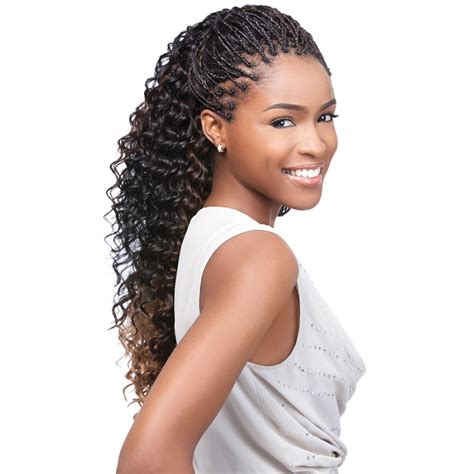Introduction

For centuries, human hair has been woven into intricate braids, adorning heads and capturing the attention of admirers. From ancient African queens to contemporary fashion icons, braided human hair has transcended cultures and time, embodying both beauty and cultural significance. In recent years, the demand for braided human hair has skyrocketed, driven by its versatility, natural aesthetic, and multiple applications. This article delves into the fascinating world of braided human hair, exploring its allure, benefits, and future potential.
Braided Human Hair: A Global Phenomenon
The Growing Demand:
According to the Allied Market Research, the global braided human hair market was valued at USD 1.1 billion in 2020 and is projected to reach USD 2.2 billion by 2028, registering a CAGR of 9.1%. This growth is attributed to increasing demand for natural hair extensions and protective hairstyles, particularly among women of African descent.
Cultural and Ethnic Significance:
Braided human hair holds deep cultural and ethnic significance, especially in Africa. Traditional African braids, such as cornrows, box braids, and locs, symbolize identity, beauty, and status within various tribes and communities. Today, these braids are embraced globally as a celebration of African heritage and a symbol of female empowerment.
The Benefits of Braided Human Hair
Natural Appearance:
Unlike synthetic hair extensions, braided human hair blends seamlessly with one’s own hair, offering a natural and authentic look.
Versatility:
Braided human hair can be styled in countless ways, from classic braids to intricate updos, allowing individuals to express their creativity and adapt to different occasions.
Protective Hairstyle:
Braids protect natural hair from damage caused by heat, chemicals, and environmental factors. They also reduce breakage and promote hair growth.
Long-Lasting:
Braided human hair extensions can last for months with proper care, providing a cost-effective alternative to frequent trips to the salon.
Customer Pain Points and Motivations
Pain Points:
- Damage to natural hair from chemical treatments and styling tools
- Thinning hair and loss of volume
- Limited styling options for short or damaged hair
Motivations:
- Desire for long, natural-looking hair
- Protection against hair damage
- Cultural expression and empowerment
- Convenience and time-saving
Applications and Future Potential
Fashion and Beauty:
Braided human hair is primarily used for hair extensions and protective hairstyles. It enhances hair volume, length, and texture, meeting the needs of individuals seeking a glamorous or traditional look.
Medical:
Braided human hair is also used in medical applications, such as creating prosthetic hairpieces for individuals who have lost their hair due to alopecia, cancer treatment, or other medical conditions.
Future Potential:
- Bio-based materials: Developing braided human hair extensions from sustainable and environmentally-friendly materials.
- Customizable braids: Offering personalized braid designs tailored to individual preferences and hair textures.
- Braided hair wigs: Creating natural-looking wigs using braided human hair for full hair coverage and versatility.
Braided Human Hair Extensions: Pros and Cons
Pros:
- Natural look and feel
- Protects natural hair from damage
- Long-lasting with proper care
- Versatile styling options
Cons:
- High cost compared to synthetic extensions
- Requires professional installation and maintenance
- May cause discomfort or tension in some individuals
Comparison of Braided Human Hair and Synthetic Hair Extensions
| Feature | Braided Human Hair | Synthetic Hair |
|---|---|---|
| Appearance | Natural and authentic | Artificial and shiny |
| Texture | Soft and silky | Harsh and unnatural |
| Longevity | Months with proper care | Weeks to a few months |
| Styling | Versatile and customizable | Limited styling options |
| Cost | Higher | Lower |
Tables
Table 1: Types of Braided Human Hair Extensions
| Type | Description |
|---|---|
| Cornrows | Thin, close-knit braids that lie flat against the head |
| Box braids | Square-shaped braids that create a bold and voluminous look |
| Dreadlocks | Tangled and matted braids that often include beads or accessories |
| Braided buns | Braids that are coiled and pinned into a bun |
Table 2: Benefits and Applications of Braided Human Hair
| Benefit | Application |
|---|---|
| Natural appearance | Hair extensions, wigs, protective hairstyles |
| Protection from damage | Protecting hair from heat, chemicals, and environmental factors |
| Cultural expression | Celebration of African heritage, symbol of female empowerment |
| Convenience | Time-saving alternative to frequent hair treatments |
Table 3: Customer Pain Points and Motivations
| Pain Point | Motivation |
|---|---|
| Damage to natural hair | Desire for long, natural-looking hair |
| Thinning hair and loss of volume | Protection against hair damage |
| Limited styling options | Cultural expression, versatility |
Table 4: Comparison of Braided Human Hair and Synthetic Hair Extensions
| Feature | Braided Human Hair | Synthetic Hair |
|---|---|---|
| Lifespan | Months with proper care | Weeks to a few months |
| Cost | Higher | Lower |
| Natural appearance | Yes | No |
| Heat resistance | Yes | No |
| Styling options | Versatile | Limited |
Conclusion
Braided human hair has become a global phenomenon, captivating the beauty and fashion industry with its natural aesthetic, versatility, and cultural significance. Its benefits, including natural appearance, protective properties, and long-lasting durability, make it a popular choice for individuals seeking to enhance their hair volume, length, and texture. As the demand for braided human hair continues to grow, innovative applications and customizable options are emerging to meet the evolving needs of consumers. From fashion statements to medical solutions, the allure of braided human hair is set to continue inspiring and connecting people across cultures for years to come.
